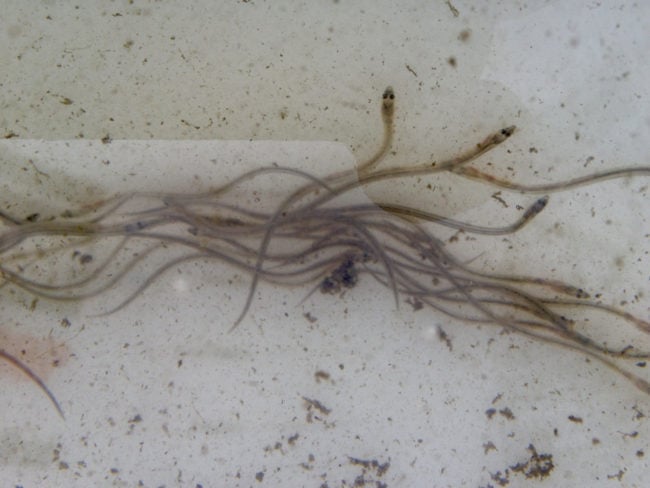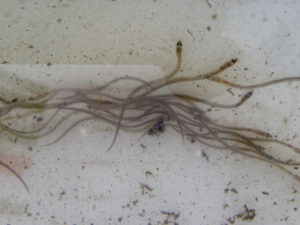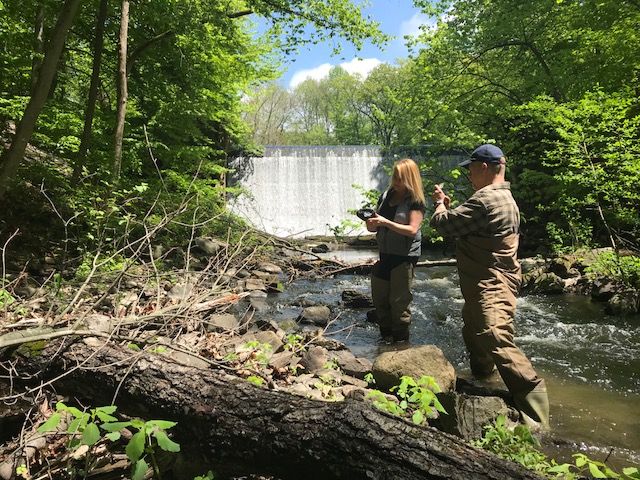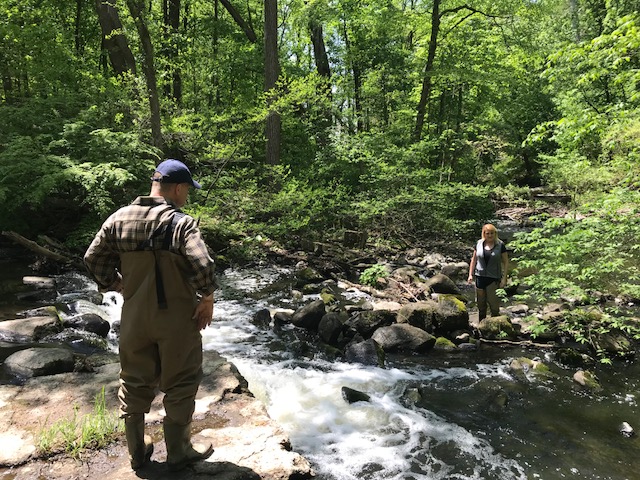At Furnace Brook in Westchester, a surprising diversity of fish

Glass eels from the Bronx River, carried by bucket over a dam at 182nd Street in the Bronx. (Photo: George Jackman)
View more images on our Flickr site
Earlier this month Riverkeeper took part in a fish sampling survey with students from SUNY College of Environmental Science and Forestry, and found a surprisingly diverse aquatic community just below a dam on the Furnace Brook, one of two and the closest to the Hudson.
This small, obsolete dam is essentially unknown.because of its low height. That means little to fish, since regardless of height, it blocks them all the same.
Furnace Brook was once known as the Jamawissa Creek, “place of small beaver,” by Native Americans. Two dams on the creek are slated to be removed through our efforts at Riverkeeper to restore the migrations of fish.
With international exchange students under the guidance of fisheries ecologist Karin Limburg, Ph.D., we performed an “electroshock survey” on June 4 aiming to form a baseline of information on species composition and to begin to quantify the effects of dams on migratory fish. We used a backpack electroshocker with several students surrounding the shocker with scap nets to collect the fish. Electroshocking is a common scientific method used to sample fish populations for abundance, density and diversity; it uses a weak electric current to stun the fish just long enough to effect capture. All organisms were quickly released unharmed after identification.
Within 30 meters below the dam, we encountered the following:
crayfish native 1 (spiny-cheeked)
brown bullhead 2
common shiner 5
glass eel 3
elvers and yellow eels 13
tessellated darter 1
bluegill 13
redbreast sunfish 2
We saw but missed approximately two times as many sunfish and three times as many eels as we caught. We discovered a high density of eels below the dam, which we had expected.

Glass eels from the Bronx River, carried by bucket over a dam at 182nd Street in the Bronx. (Photo: George Jackman)
American eels are born in the salty Sargasso Sea, where they hatch from eggs and begin their migration following ocean currents northwards to the Hudson River, where along the way they metamorphose into tiny glass eels.
Glass eels enter the Hudson River en masse in late winter and early spring and able to from the to penetrate the myriad of freshwater creeks and streams that will serve as critical habitat until they reach sexually maturity, which is anywhere from 8 to 21 years and for some females may be as long as 30 to 40 years. At some point in their lives, the eels are cued to return to the Sargasso Sea to spawn and die. Like other diadromous fish, American eels regulate their salt concentrations in order to switch habitats.
The high density of eels below the dams is problematic because their sex is environmentally determined, and eels in high density are destined to become males. In order to become females, juvenile eels have to migrate far upstream to escape competitive stress caused by other eels, in order to grow large and fecund, but their way is often blocked.
Unfortunately American eels have declined precipitously over the years due to over-exploitation and habitat loss, mostly due to dams.
Eels, like other migratory fish are blocked by dams, and approximately 90 percent of each tributary’s glass eel population is blocked from moving upstream by each successive dam. Eels have lost approximately one-third of their habitat, and no longer make it to the Great Lakes.
The downstream migration is especially fraught, particularly from hydropower dams where they become entrained in the turbine intakes and diced by the whirling blades.
The first two dams in the Jamawissa are slated for deconstruction some time next year. As we remove dams on Hudson River tributaries like this one, we intend to study the populations of aquatic organisms before and after removal. Towards this goal we strongly encourage local high schools and colleges to engage in these studies to help further our efforts and because this is potentially groundbreaking research in many ways.
The ESF students steadfastly and enthusiastically engaged their mission on the Jamawissa. All the students involved were graduate level students mostly from Europe who are involved in aquatic ecology or other aspects of aquatic science. One of the most interesting aspects of aquatic ecology is determining what lies below the surface of a body of water. I think most people have the same innate curiosity when looking at dark stained waters, and wonder what lies below the murky waters and how do they live there.
It is satisfying to watch students collectively engage a task and work to improve science, simply in the name of curiosity and wonder.
Learn more:
Hudson River fish migration: A reason and a season


